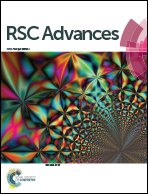Freestanding and flexible graphene wrapped MnO2/MoO3 nanoparticle based asymmetric supercapacitors for high energy density and output voltage†
Abstract
Asymmetric supercapacitors (ASC) based on freestanding membranes with high energy density and high output voltage by a simple pre-reduced and vacuum filtering method are reported. Reduced graphene oxide (rGO) coated MnO2 nanospheres and rGO coated MoO3 nanoparticle composites are selected as the positive and the negative materials of the devices, respectively. The ASC has a high operation voltage window of 2.0 V in a hydrogen electrolyte, a high energy density of 34.6 mW h cm−3 at a power density of 100 mW cm−3, and a high volumetric capacitance of 62.7 F cm−3 at a current density of 0.1 A cm−3. Especially, the ASC exhibits an excellent cycling performance of 94.2% capacitance retention after over 3000 cycles. This strategy of designing the hybridized structure for freestanding and flexible ASC provides a promising route for next-generation supercapacitors with high energy density and high output voltage.


 Please wait while we load your content...
Please wait while we load your content...